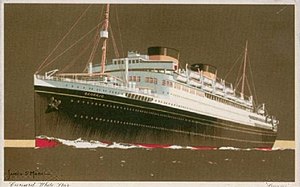MV Georgic (1932)

MV Georgic
|
|
| History | |
|---|---|
|
|
|
| Name: | MV Georgic |
| Owner: |
|
| Route: | Liverpool - New York |
| Builder: | Harland and Wolff |
| Yard number: | 896 |
| Launched: | 1931 |
| Completed: | 10 June 1932 |
| Maiden voyage: | 25 June 1932 |
| In service: | 1932-1941, 1945-1956 |
| Out of service: | 1956 |
| Fate: | Bombed and sunk July 1941, salvaged by Shipbreaking Industries Ltd October 1941, refloated and refurbished 1942-1944, resumed service as a troop transport in 1945, resumed civilian service 1948, scrapped 1956. |
| Status: | Scrapped 1956 |
| General characteristics | |
| Tonnage: | 27,759 gross tons |
| Length: | 711 ft (216.7 m) |
| Propulsion: | Twin propellers, diesel electric propulsion |
| Speed: | 19 knots (35 km/h; 22 mph) |
| Capacity: | 1,400 passengers |
Built at Harland and Wolff shipyard in Belfast, the MV Georgic was the last ship built for the White Star Line before its merger with the Cunard Line. She was the running mate of Britannic. Like Britannic, Georgic was a motorship, and not a steamer, fitted with a diesel electric powerplant.
She was built for the Liverpool–New York route. She was launched in 1931, and, after fitting out sailed her maiden voyage on 25 June 1932. In 1933, she replaced the aging RMS Olympic on the Southampton–New York route for a brief time while that vessel was overhauled.
Her design was very similar to that of Britannic, with a sleek profile and two squat smokestacks. She was equipped with a diesel power plant which powered electric motors, which in turn drove the propellers. She recorded a top speed of 19 knots on her speed trials. At 711 ft long (217 m) and 27,759 gross tons she was not the largest liner of her time, but was considered very stylish and a favourite among passengers. She helped keep the White Star Line afloat during the Great Depression.
In January 1933 Georgic began to sail the Southampton to New York route. This was mainly in order to replace the larger RMS Olympic during her major overhaul. On 10 May 1934 the ship became part of the fleet of the newly amalgamated Cunard-White Star Line, and Georgic joined Britannic on the London, Southampton, New York route. This made the ship the largest to use the River Thames. In August 1939 Georgic returned to the Liverpool to New York route and made five round trips before being requisitioned for trooping duties in the conflicts of World War II.
...
Wikipedia
